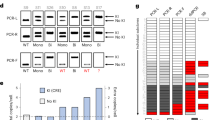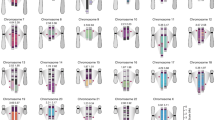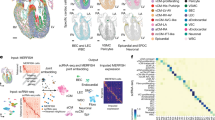Abstract
Escherichia coli-based artificial chromosomes have become important tools for physical mapping and sequencing in various genome projects. The lack of a general method to modify these large bacterial clones, however, has limited their utility in functional studies. We developed a simple method to modify bacterial artificial chromosomes directly in the recombination-deficient E. coli host strain by homologous recombination for in vivo studies. The IRES-LacZ marker gene was introduced into a 131 kb BAG containing the murine zinc finger gene, RU49. No rearrangements or deletions were detected in the modified BACs. Furthermore, transgenic mice were generated by pronuclear injection of the modified BAG, and germline transmission of the intact BAG has been obtained. Proper expression of the lacZ transgene in the brain has been observed, which could not be obtained with conventional transgenic constructs.
This is a preview of subscription content, access via your institution
Access options
Subscribe to this journal
Receive 12 print issues and online access
$209.00 per year
only $17.42 per issue
Buy this article
- Purchase on Springer Link
- Instant access to full article PDF
Prices may be subject to local taxes which are calculated during checkout
Similar content being viewed by others
References
Jaenisch, R. 1988. Transgenic animals. Science 240: 1468–1474.
Palmiter, R.D. and Brinster, R.L. 1985. Transgenic mice. Cell 41: 343–345.
Dillon, N. and Grosveld, F. 1993. Transgenic regulation of multigene loci: multilevel control. Trends Genet. 9: 134–137.
Kennison, J.A. 1993. Transcriptional activation of Drosophila homeotic genes from distant regulatory elements. Trends Genet. 9: 75–79.
Wilson, C., Bellen, H.G., and Gehring, W.J. 1990. Position effects on eukaryotic gene expression. Annu. Rev. Cell. Biol. 6: 679–714.
Burke, D.T., Carle, G.F., and Olson, M.V. 1987. Cloning of large segments of exogenous DMA into yeast artificial chormosomes. Science 236: 806–812.
Monaco, A.P. and Larin, Z. 1994. YACs, BCs, PACs and MACs: artificial chromosomes as research tools. Trends Biotech. 12: 280–286.
Spencer, F., Ketner, G., Connelly, C., and Hieter, P. 1993. Targeted recombination-based cloning and manipulation of large DNA segments in yeast. Methods Enzymol 5: 161–175.
Hieter, P., Connelly, C., Shero, J., McCormick, M.K., Antonarakis, S., Pavan, W. et al. 1990. Yeast artificial artificial chromosomes: promises kept and pending, pp. 83–120 in Genome analysis: genetic and physical mapping, Vol. 1. Davies, K.E. and Tilghman, S. (eds.) Cold Spring Harbor Laboratory Press, New York.
Peterson, K.R., Clegg, C.H., Li, Q., and Stamatoyannopoulos, G. 1997. Production of transgenic mice with yeast artificial chromosomes. Trends Genet. 13: 61–66.
Green, E.D., Riethman, H.C., Dutchik, J.E., and Olson, M.V. 1991. Detection and characterization of chimeric yeast artificial chromosome clones. Genomics 11: 658–669.
Kouprina, N., Eldarov, M., Moyzis, R., Resnick, M.A., and Larionov, V. 1994. A model system to assess the integrity of mammalian YACs during transformation and propogation in yeast. Genomics 21: 7–17.
Larionov, V., Kouprina, N., Nikolaishvili, N., and Resnick, M.A. 1994. Recombination during transformation as a source of chimeric mammalian artificial chromosomes in yeast (YACs). Nucl. Acids Res. 22: 4154–4162.
Shizuya, H., Birren, B., Kirn, U.-J., Mancino, V., Tatiana, S. Tachiiri, Y., et al. 1992. Cloning and stable maintenance of 300-kilobase-pair fragments of human DNA in Escherichia coli using an F-factor-based vector. Proc. Natl. Acad. Sci. USA 89: 8794–8797.
Hosoda, F., Nishimura, S., Uchida, H., and Ohki, M. 1990. An F factor based cloning system for large DNA fragments. Nucl. Acids Res. 18: 3863–3869.
Ioannou, P.A., Amemiya, C.T., Garnes, J., Kroisel, P.M., Shizuya, H., Chen, C., et al. 1994. A new bacteriophage P1-derived vector for the propagation of large human DNA DNA fragments. Nature Genetics 6: 84–90.
Woo, S.-S., Jiang, J., Gill, B.S., Paterson, A.H., and Wing, R.A. 1994. Construction and characterization of a bacterial artificial chromosome library of Sorghum bicolor. Nucl. Acids Res. 22: 4922–4931.
Kim, U.-J., Shizuya, H., Kang, H.L., Choi, S.S., Garrett, C.L., Smink, L.J. et al. 1996. A bacterial artificial chromosome-based framework contig map of human chromosome 22q. Proc. Natl. Acad. Sci. USA 93: 6297–6301.
Wang, M., Chen, X., Shouse, S., Manson, J., Wu, Q., Li, R., et al. 1994. Construction and characterization of a human chromosome 2-specific BAC library. Genomics 24: 527–534.
Wooster, R., Bignell, G., Lancaster, J., Swift, S., Seal, S., Mangion, J. et al. 1995. Identification of the breast cancer susceptibility gene BRCA2. Nature 378: 789–792.
Yang, X.W., Zhong, R., and Heintz, N. 1996. Granule cell specification in the developing mouse brain as defined by expression of the zinc finger transcription factor RU49. Development 122: 555–566.
O'Connor, M., Peifer, M., and Bender, W. 1989. Construction of large DNA segments in Escherichia coli. Science 244: 1307–1312.
Hamilton, C.M., Aldea, M., Washburn, B.K., Babitzke, P., and Kushner, S.R. 1989. New method for generating deletions and gene replacements in Escherichia coli. J. Bacteriol. 171: 4617–4622.
Hashimoto-Gotoh, T. and Sekiguchi, M. 1977. Mutations to temperature sensitivity in R plasmid pSC101. J. Bacteriol. 131: 405–412.
Bochner, B.R., Huang, H., Schieven, G.L., and Ames, B.N. 1980. Positive selection for loss of tetracycline resistance. J. Bacteriol. 143: 926–933.
Maloy, S.R., and Nunn, W.D. 1981. Selection for loss of tetracycline resistance by Escherichia coli. J. Bacteriol. 146: 1110–1112.
Pelletier, J. and Sonenberg, N. 1988. Internal binding of ribosomes to the 5′ noncoding region of an eukaryotic mRNA: translation of poliovirus. Nature 334: 320–325.
Schedl, A., Larin, Z., Montoliu, L., Thies, E., Kelsey, G., Lehrach, H. et al. 1993. A method for the generation of YAC transgenic by pronuclear injection. Nucl. Acids Res. 21: 4383–4387.
Gnirke, A., Huxley, C., Peterson, K., and Olson, M.V. 1993. Microinjection of intact 200- to 500-kb fragments of YAC DNA into mammalian cells. Genomics 15: 659–667.
Hogan, B., Constantini, F., and Lacy, E. 1986. Manipulating the Mouse Embryo (Cold Spring Harbor Laboratory Press, New York).
Bradley, A., and Liu, P. 1996. Targeted pratice in transgenics. Nature Genetics 14: 121–123.
Kuhn, R., Schwenk, F., and Rajewsky, K. 1995. Inducible gene targeting in mice. Science 269: 1427–1429.
Tsien, J.Z., Chen, D.F., Gerber, D., Tom, C., Mercer, E.H., Anderson, D.J., et al. 1996. Subregion and cell type-restricted gene knockout in mouse brain. Cell 87: 1317–1326.
Kim, D.G., Kang, H.M., Jang, S.K., and Shin, H.S. 1992. Construction of a bifunctional mRNA in the mouse using the internal ribosomal entry site of the encephalomyocarditis virus. Mol. Cell. Biol. 12: 3636–3643.
Author information
Authors and Affiliations
Corresponding author
Rights and permissions
About this article
Cite this article
Yang, X., Model, P. & Heintz, N. Homologous recombination based modification in Esherichia coli and germline transmission in transgenic mice of a bacterial artificial chromsome. Nat Biotechnol 15, 859–865 (1997). https://doi.org/10.1038/nbt0997-859
Received:
Accepted:
Issue Date:
DOI: https://doi.org/10.1038/nbt0997-859
This article is cited by
-
Updates on mouse models of Alzheimer’s disease
Molecular Neurodegeneration (2024)
-
High-efficiency genetic engineering toolkit for virus based on lambda red-mediated recombination
Biotechnology Letters (2023)
-
Genetic quality: a complex issue for experimental study reproducibility
Transgenic Research (2022)
-
Versatile functional roles of horizontal cells in the retinal circuit
Scientific Reports (2017)
-
Establishment of high reciprocal connectivity between clonal cortical neurons is regulated by the Dnmt3b DNA methyltransferase and clustered protocadherins
BMC Biology (2016)



